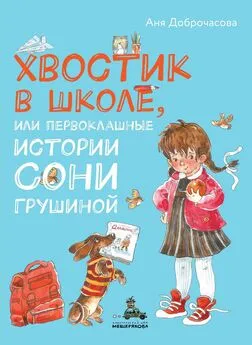Зази Тодд - Счастливый хвостик
- Название:Счастливый хвостик
- Автор:
- Жанр:
- Издательство:Манн, Иванов и Фербер
- Год:2021
- Город:Москва
- ISBN:9785001697305
- Рейтинг:
- Избранное:Добавить в избранное
-
Отзывы:
-
Ваша оценка:
Зази Тодд - Счастливый хвостик краткое содержание
Счастливый хвостик - читать онлайн бесплатно ознакомительный отрывок
Интервал:
Закладка:
151
Yasemin Salgirli Demirbas et al. “Adults’ ability to interpret canine body language during a dog — child interaction,” Anthrozoös 29, no. 4 (2016): 581–596.
152
K. Meints, A. Racca and N. Hickey. “How to prevent dog bite injuries? Children misinterpret dogs facial expressions,” Injury Prevention 16, Suppl 1 (2010): A68.
153
Christine Arhant, Andrea Martina Beetz and Josef Troxler. “Caregiver reports of interactions between children up to 6 years and their family dog — implications for dog bite prevention,” Frontiers in Veterinary Science 4 (2017): 130.
154
Christine Arhant et al. “Attitudes of caregivers to supervision of child-family dog interactions in children up to 6 years — an exploratory study,” Journal of Veterinary Behavior 14 (2016): 10–16.
155
Jiabin Shen et al. “Systematic review: Interventions to educate children about dog safety and prevent pediatric dog-bite injuries: A meta-analytic review,” Journal of Pediatric Psychology 42, no. 7 (2016): 779–791.
156
Sato Arai, Nobuyo Ohtani and Mitsuaki Ohta. “Importance of bringing dogs in contact with children during their socializationiod for better behavior,” Journal of Veterinary Medical Science 73, no. 6 (2011): 747–752.
157
Carlo Siracusa, Lena Provoost and Ilana R. Reisner. “Dog- and owner-related risk factors for consideration of euthanasia or rehoming before a referral behavioral consultation and for euthanizing or rehoming the dog after the consultation,” Journal of Veterinary Behavior 22 (2017): 46–56.
158
Dawn Brooks et al. “2014 AAHA weight management guidelines for dogs and cats,” Journal of the American Animal Hospital Association 50, no. 1 (2014): 1–11.
159
C.A. Pugh et al. “Dogslife: A cohort study of Labrador Retrievers in the UK,” Preventive Veterinary Medicine 122, no. 4 (2015): 426–435.
160
Sarah E. Lofgren et al. “Management andsonality in Labrador Retriever dogs,” Applied Animal Behaviour Science 156 (2014): 44–53.
161
Tiffani J. Howell, Kate Mornement and Pauleen C. Bennett. “Pet dog management practices among a representative sample of owners in Victoria, Australia,” Journal of Veterinary Behavior 12 (2016): 4–12.
162
Carri Westgarth et al. “Dog behavior on walks and the effect of use of the leash,” Applied Animal Behaviour Science 125, no. 1–2 (2010): 38–46.
163
Carri Westgarth et al. “I walk my dog because it makes me happy: A qualitative study to understand why dogs motivate walking and improved health,” International Journal of Environmental Research and Public Health 14, no. 8 (2017): 936.
164
Chris Degeling and Melanie Rock. “‘It was not just a walking experience’: Reflections on the role of care in dog-walking,” Health Promotion International 28, no. 3 (2012): 397–406.
165
Christine Arhant et al. “Behaviour of smaller and larger dogs: Effects of training methods, inconsistency of owner behaviour and level of engagement in activities with the dog,” Applied Animal Behaviour Science 123, no. 3–4 (2010): 131–142.
166
Chris Degeling, Lindsay Burton and Gavin R. McCormack. “An investigation of the association between socio-demographic factors, dog-exercise requirements, and the amount of walking dogs receive,” Canadian Journal of Veterinary Research 76, no. 3 (2012): 235–240.
167
Hayley Christian et al. “Encouraging dog walking for health promotion and disease prevention,” American Journal of Lifestyle Medicine 12, no. 3 (2018): 233–243.
168
Amanda Jane Kobelt et al. “The behaviour of Labrador Retrievers in suburban backyards: The relationships between the backyard environment and dog behaviour,” Applied Animal Behaviour Science 106, no. 1–3 (2007): 70–84.
169
Westgarth et al. “Dog behavior on walks.”
170
Rachel Moxon, H. Whiteside and Gary C.W. England. “Incidence and impact of dog attacks on guide dogs in the UK: An update,” Veterinary Record 178, no. 15 (2016): 367.
171
San Francisco Society for the Prevention of Cruelty to Animals (SF SPCA). “Prong collars: Myths and facts,” Accessed March 31, 2018, sfspca.org/prong/myths.
172
John Grainger, Alison P. Wills and V. Tamara Montrose. “The behavioral effects of walking on a collar and harness in domestic dogs (Canis familiaris),” Journal of Veterinary Behavior 14 (2016): 60–64.
173
Nicola J. Rooney and John W.S. Bradshaw. “An experimental study of the effects of play upon the dog — human relationship,” Applied Animal Behaviour Science 75, no. 2 (2002): 161–176.
174
Ragen T.S. McGowan et al. “Positive affect and learning: Exploring the ‘Eureka Effect’ in dogs,” Animal Cognition 17, no. 3 (2014): 577–587.
175
Christine Arhant et al. “Behavior of smaller and larger dogs: Effects of training methods, inconsistency of owner behaviour and level of engagement in activities with the dog,” Applied Animal Behaviour Science 123, no. 3–4 (2010): 131–142.
176
John Bradshaw and Nicola Rooney. “Dog social behavior and communication” in The Domestic Dog: Its Evolution, Behavior and Interactions with People, ed. James Serpell (Cambridge: Cambridge University Press, 2017), 133–159.
177
George M. Strain. “How well do dogs and other animals hear?” Accessed March 31, 2018, lsu.edu/deafness/HearingRange.html.
178
Lori R. Kogan, Regina Schoenfeld-Tacher and Allen A. Simon. “Behavioral effects of auditory stimulation on kenneled dogs,” Journal of Veterinary Behavior 7, no. 5 (2012): 268–275.
179
A. Bowman et al. “‘Four Seasons’ in an animal rescue centre; classical music reduces environmental stress in kennelled dogs,” Physiology & Behavior 143 (2015): 70–82.
180
Alexandra A. Horowitz. Being a Dog: Following the Dog into a World of Smell (New York: Scribner, 2016).
181
C. Duranton and A. Horowitz. “Let me sniff! Nosework induces positive judgment bias in pet dogs,” Applied Animal Behaviour Science 211 (2019): 61–66.
182
Jocelyn (Joey) M. Farrell et al. “Dog-sport competitors: What motivates people to participate with their dogs in sporting events?” Anthrozoös 28, no. 1 (2015): 61–71.
183
Camilla Pastore et al. “Evaluation of physiological and behavioral stress-dependent parameters in agility dogs,” Journal of Veterinary Behavior 6, no. 3 (2011): 188–194.
184
Anne J. Pullen, Ralph J.N. Merrill and John W.S. Bradshaw. “Habituation and dishabituation during object play in kennel-housed dogs,” Animal Cognition 15, no. 6 (2012): 1143–1150.
185
Lidewij L. Schipper et al. “The effect of feeding enrichment toys on the behavior of kennelled dogs (Canis familiaris),” Applied Animal Behaviour Science 114, no. 1–2 (2008): 182–195.
186
Jenna Kiddie and Lisa Collins. “Identifying environmental and management factors that may be associated with the quality of life of kennelled dogs (Canis familiaris),” Applied Animal Behaviour Science 167 (2015): 43–55.
187
Erik Axelsson et al. “The genomic signature of dog domestication reveals adaptation to a starch-rich diet,” Nature 495, no. 7441 (2013): 360.
188
Maja Arendt et al. “Diet adaptation in dog reflects spread of prehistoric agriculture,” Heredity 117, no. 5 (2016): 301.
189
Maja Arendt et al. “Amylase activity is associated with AMY 2B copy numbers in dog: Implications for dog domestication, diet and diabetes,” Animal Genetics 45, no. 5 (2014): 716–722.
190
Morgane Ollivier et al. “Amy2B copy number variation reveals starch diet adaptations in ancient European dogs,” Royal Society Open Science 3, no. 11 (2016): 160449.
191
Tiffani J. Howell, Kate Mornement and Pauleen C. Bennett. “Pet dog management practices among a representative sample of owners in Victoria, Australia,” Journal of Veterinary Behavior 12 (2016): 4–12.
192
C.A. Pugh et al. “Dogslife: A cohort study of Labrador Retrievers in the UK,” Preventive Veterinary Medicine 122, no. 4 (2015): 426–435.
193
Kathryn E. Michel. “Unconventional diets for dogs and cats,” Veterinary Clinics: Small Animal Practice 36, no. 6 (2006): 1269–1281.
194
Vivian Pedrinelli, Márcia de O.S. Gomes and Aulus C. Carciofi. “Analysis of recipes of home-prepared diets for dogs and cats published in Portuguese,” Journal of Nutritional Science 6 (2017): e33.
195
Andrew Knight and Madelaine Leitsberger. “Vegetarian versus meat-based diets for companion animals,” Animals 6, no. 9 (2016): 57.
196
Daniel P. Schlesinger and Daniel J. Joffe. “Raw food diets in companion animals: A critical review,” The Canadian Veterinary Journal 52, no. 1 (2011): 50.
197
Freek P.J. van Bree et al. “Zoonotic bacteria and parasites found in raw meat-based diets for cats and dogs,” Veterinary Record 182, no. 2 (2018): 50.
198
J. Boyd. “Should you feed your pet raw meat? The risks of a ‘traditional’ diet,” 2018, phys.org/news/2018-01-pet-raw-meat-real-traditional.html.
199
ASPCA Poison Control. “People foods to avoid feeding your pet,” Accessed September 30, 2018, aspca.org/pet-care/animal-poison-control/people-foods-avoid-feeding-your-pets.
200
Giada Morelli et al. “Study of ingredients and nutrient composition of commercially available treats for dogs,” Veterinary Record 182, no. 12 (2018): 351.
201
Ernie Ward, Alexander J. German and Julie A. Churchill. “The Global Pet Obesity Initiative position statement,” Accessed December 29, 2018, petobesityprevention.org/about.
202
Elizabeth M. Lund et al. “Prevalence and risk factors for obesity in adult dogs from private US veterinary practices,” International Journal of Applied Research in Veterinary Medicine 4, no. 2 (2006): 177; P.D. McGreevy et al. “Prevalence of obesity in dogs examined by Australian veterinary practices and the risk factors involved,” Veterinary Record— English Edition 156, no. 22 (2005): 695–701.
203
Alexander J. German et al. “Small animal health: Dangerous trends in pet obesity,” Veterinary Record 182, no. 1 (2018): 25.
204
Ellen Kienzle, Reinhold Bergler and Anja Mandernach. “A comparison of the feeding behavior and the human — animal relationship in owners of normal and obese dogs,” The Journal of Nutrition 128, no. 12 (1998): 2779S–2782S.
Читать дальшеИнтервал:
Закладка:







![Хелен Тодд - Призрачные нити [≈ За пеленой северного тумана] [litres]](/books/1063953/helen-todd-prizrachnye-niti-za-pelenoj-severnogo.webp)


